#northern African
Explore tagged Tumblr posts
Text


Darine Zaouia - Algerian, Unknown
#face claims central#fan cast#female face claims#female models#character inspiration#beautiful girls#fancast#face claims#models#wattpad#algerian#algerian models#algerian girls#northern african#northern african girls#northern african female models#poc#poc female models#poc face claims#poc rp#poc models#rpg oc#rp oc#oc rp#rp#rpg
18 notes
·
View notes
Text


3 notes
·
View notes
Text
cherry blossom villages NOW
I CHOKED ON MY DRINK
NEW MINECRAFT BIOME LETS GOOOOOOOOO CHERRY BLOSSOM BIOME BABY

#it would be so cute if we can have eastern asian type villages#i mean#we have the north pole#idk what's it is called but northern european type#southern african type houses (i think?)#northern african#NOW LETS GET ASIAN TYPE HOUSES#minecraft
4K notes
·
View notes
Text

Sketch of the day: Modern AU?
My idea for this is that Soren's father is an extremely corrupt Trump-like business man who had his wife institutionalized to prevent her from talking about abuse. Due to this Soren has been in foster care from a very young age. I know most people go for a goth/punk look for him but this time I went with a kid who tries to dress low-key/ a little nicely but he has a hard time because his clothes are second hand and don't fit right.
Ike and Mist are from a very loving, solidly middle class home with parents whom are well liked and respected in the community. They struggle a bit with the loss of their mother but for the most part they're very well adjusted. Ike in particular is the jock who doesn't tolerate bullying at his school! Its easy to imagine that his life revolves around some kind of contact heavy sport like football or wrestling, which his father no doubt coaches.
#soren has a scar on his forehead from being dropped as a baby lol#I figure almedha is still struggling because she's living in her husband's home county and is far from her own#I've always liked the idea that in a modern au the dragons would be middle eastern/northern african#or in general from an arabic speaking area#soren might know who his father is but still never met him#tellius au#modern au#soren#ike#mist
81 notes
·
View notes
Text
Why Iron Goddess of Mercy is the best oolong tea:
Superb 10/10 name (Chinese: Tieguanyin)
Even the type of tea has a badass name: 烏龍茶, "dark dragon tea" like come on
Every cup tastes a little different. It's usually faintly nutty, but today my cup tasted slightly cinnamon-y
Super easy to clean out of the steeper ball thing because it's just big leaves
AFFORDABLE
Still tastes good even after it cools off a little
You can get like 4-5 cups out of one teaspoon of leaves so a bag of it lasts forever
🔥IRON GODDESS OF MERCY OOLONG TEA FOREVER🔥
#textpost#I loooove Chinese teas but I've had some killer stuff from India and northern African countries too#Tunisian tea is always awesome but it's hard/expensive to get...#I generally order from Teasource because they work with the farmers and it's ethical/sustainable#Sometimes the co-op up the road has good stuff too though
168 notes
·
View notes
Text
Round 4: Elite Trait


Northern Elephant Seal vs African Forest Elephant
Arena: Desert
Remember, it's not a popularity contest-- it's a fight to the death!
#northern elephant seal#african forest elephant#may mammal madness#mmm24 round four#mmm24 polls#elite trait#take a bow
40 notes
·
View notes
Text

Char Matilda II du 7th Royal Tank Regiment – Opération Compass – Campagne d'Afrique du Nord – 19 décembre 1940
Photographe : Capitaine Geoffrey John Keating - No. 1 Army Film and Photo Section, Army Film and Photographic Unit
©Imperial War Museums - E 1416
#WWII#campagne d'afrique du nord#north african campaign#opération compass#operation compass#armée britannique#british army#7e régiment royal de chars#7th royal tank regiment#char#tanks#char d'infanterie#infantry tank#matilda II#afrique du nord#northern africa#19/12/1940#12/1940#1940
28 notes
·
View notes
Text
accidentally opened tinder in helsinki airport and activated every antti tommi and ville in a 20 mile radius....im sorry boys we are like ships passing in the night
#im unfortunately promised to a diff northern european city#that's filled w middle eastern and african guys named HAND$OME LOVR who dress in fits from adult mens baby gap#and are obsessed w me for some reason
7 notes
·
View notes
Text

The unnamed Princess of Dorne
#valyrianscrolls#dornesource#a song of ice and fire fanart#asoiaf#the unnamed princess of dorne#as always heavy inspired by Northern African fashion#brartist#brart#mine#corpse draws#artists of tumblr
136 notes
·
View notes
Text
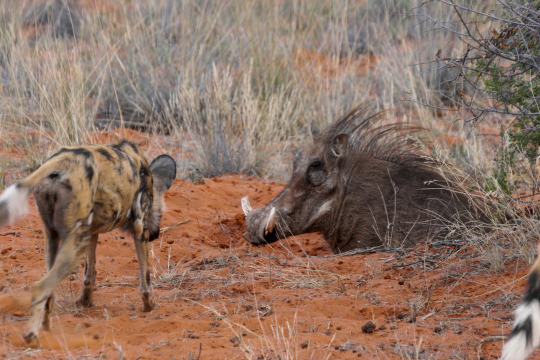
Southern warthog Phacochoerus africanus sundevallii
with African painted dog Lycaon pictus
Observed by tanderson, CC BY-NC
#Phacochoerus africanus sundevallii#southern warthog#Suidae#pig#non-ungulate#carnivoran#dog#Lycaon pictus#African painted dog#Africa#South Africa#Northern Cape
40 notes
·
View notes
Text
sort of can't stop thinking about this sign on the bus and how it skips every major european language usually used on multilingual informational signs. very fun to see that specifically the "not paying the bus fare will lead to a fine and possibly police involvement" sign is in the languages of the main minorities in the city

#totally not racist northern italy be like. i will put up this sign for the africans romanians and arabs only <3#well.#veni veni#erasmus tag
3 notes
·
View notes
Text


Younes Kahlaoui - Moroccan Russian, Unknown
#face claims central#character inspiration#models#fancast#fan cast#wattpad#face claims#male models#arab male models#arab fc#arab male#arab models#arab#arabic#moroccan#moroccan models#moroccan male models#moroccan face claims#north african#northern african#northern african male#north african models#poc#poc models#poc rp#poc male models#rpg#rp oc#oc rp
18 notes
·
View notes
Text
Sitting white americans down and holding their hands and giving them a cup of tea and gently explaining that Not All Black People Are American
#a take i saw earlier today lol#and that ive seena. few times in my life#its just. so weird.#do i know their races? no#but irl ive ONLY seen white ppl say that#its really really weird.#god i forget what i took but i took some sort of online test the other day with a demographic queationnaire for research purposes#and the Black options were “african-american” and “Black african”#HUH????#i had major beef with that one tho the ethnicity options were. weird.#eg it had like “northern Indigenous (Inuit)”#like ok. um.#wh... why not the others?? what about the yupik? or aleut?#like even if its America centric that option Didnt Make Sense#only reason i can possibly understand is that it was made by undergrad students or something who didnt get their prof to look at the list#like i cannot emphasise how weird “northern Indigenous (Inuit)” is
6 notes
·
View notes
Text
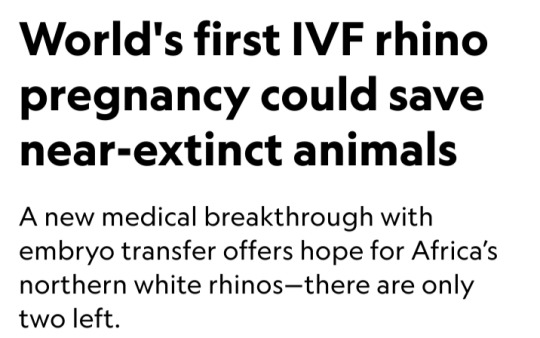

By Dina Fine Maron
January 24, 2024
Scientists have cleared a significant hurdle in the years-long effort to save Africa’s northern white rhinoceros from extinction with the first-ever rhino pregnancy using in vitro fertilization.
The lab-assisted pregnancy, which researchers will announce today, involved implanting a southern white rhino embryo in a surrogate mother named Curra.
The advance provides the essential “proof of concept” that this strategy could help other rhinos, says Jan Stejskal of the BioRescue project, the international group of scientists leading this research.
Curra died just a couple months into her 16-month pregnancy from an unrelated bacterial infection, Stejskal says.
However, the successful embryo transfer and early stages of pregnancy pave the way for next applying the technique to the critically endangered northern white rhino.
The process was documented exclusively by National Geographic for an upcoming Explorer special currently slated to air in 2025 on Nat Geo and Disney+.
BioRescue expects to soon implant a northern white rhino embryo into a southern white rhino surrogate mother.
The two subspecies are similar enough, according to the researchers, that the embryo will be likely to develop.
Eventually, this approach may also help other critically endangered rhinos, including the Asian Javan rhinoceros and the Sumatran rhinoceros, which each now number under 100 individuals, Stejskal says.
But the northern white rhino’s current situation is the most pressing by far.
There are no males left, and the only two remaining animals are both elderly females that live under armed guard on a reserve in a 700-acre enclosure in Kenya called Ol Pejeta Conservancy.
The boxy-jawed animals once roamed across central Africa, but in recent decades, their numbers have plummeted due to the overwhelming international demand for their horn, a substance used for unproved medicinal applications and carvings.
Made from the same substance as fingernails, rhino horn is in demand from all species, yet the northern white rhino has been particularly hard-hit.
"These rhinos look prehistoric, and they had survived for millions of years, but they couldn’t survive us,” says Ami Vitale, a National Geographic Explorer and photographer who has been documenting scientists’ efforts to help the animals since 2009.
“If there is some hope of recovery within the northern white rhino gene pool — even though it’s a substantially smaller sample of what there was — we haven’t lost them,” says conservation ecologist David Balfour, who chairs the International Union for the Conservation of Nature’s African rhino specialist group.
Blueprints for rhino babies
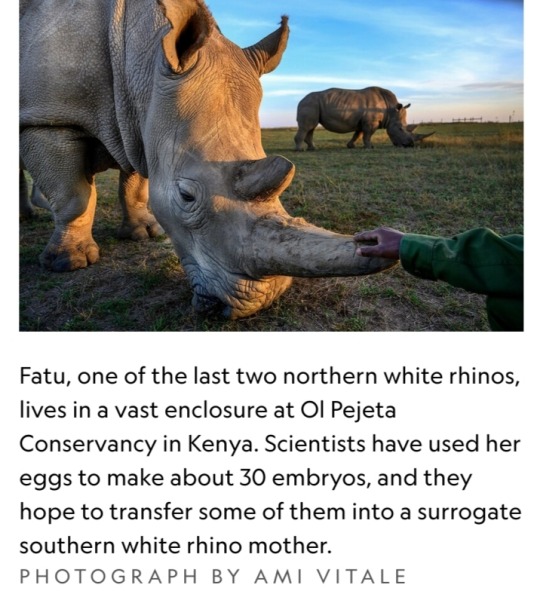
To stave off the animal’s disappearance, BioRescue has used preserved sperm from northern white rhinos and eggs removed from the younger of the two remaining females.
So far, they’ve created about 30 preserved embryos, says Thomas Hildebrandt, the head scientist of BioRescue and an expert in wildlife reproduction based at the Leibniz-Institute of Zoo and Wildlife Research in Berlin.
Eventually, the team plans to reintroduce northern white rhinos into the wild within their range countries.
“That’d be fantastic, but really, really far from now—decades from now,” says Stejskal.
Worldwide, there are five species of rhinoceros, and many are in trouble.
Across all of Africa, there are now only about 23,000 of the animals, and almost 17,000 of them are southern whites.
Then there are more than 6,000 black rhinos, which are slightly smaller animals whose three subspecies are critically endangered.
In Asia, beyond the critically endangered Javan and Sumatran rhinos, there’s also the greater one-horned rhino, whose numbers are increasing and currently are estimated to be around 2,000.
The BioRescue effort has experienced many setbacks, and even though the team now has frozen embryos, the clock is ticking.
The researchers intend to use southern white rhinos as surrogate moms for the northern white rhino embryos.
However, scientists want any northern white rhino calves to meet and learn from others of their kind, which means they need to be born before the two remaining females die.
“These animals learn behaviors — they don’t have them genetically hard-wired,” says Balfour, who’s not involved with the BioRescue work.
But birthing new animals in time will be a challenge.
“We’re really skating on the edge of what’s possible,” he says, “but it’s worth trying.”
Najin, the older female, will be 35 this year, and Fatu will be 24.
The animals, which were born in a zoo in the Czech Republic, are expected to live to about 40, says Stejskal, who also serves as director of international projects at the Safari Park Dvůr Králové, the zoo where the animals lived until they were brought to Kenya in 2009.
Impregnating a rhino
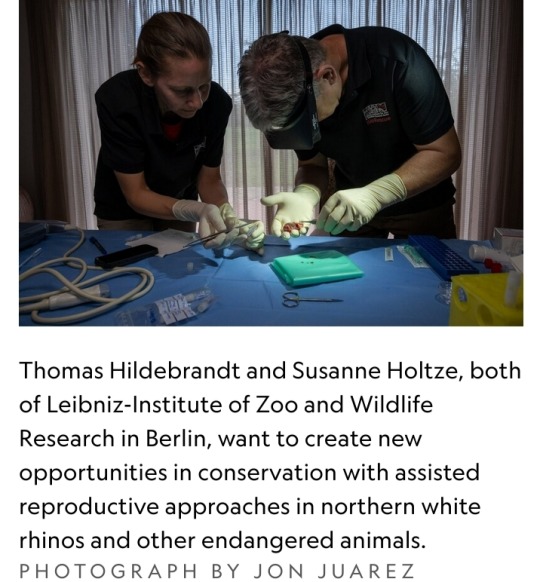
The next phase of BioRescue’s plan involves implanting one of their limited number of northern white rhino embryos into a southern white rhino surrogate mother — which the group plans to do within the next six months, Stejskal says.
They’ve identified the next surrogate mother and set up precautions to protect her from bacterial infections, including a new enclosure and protocols about disinfecting workers’ boots.
But now, they must wait until the female rhino is in estrus — the period when the animal is ready to mate — to implant the egg.
To identify that prime fertile time, they can’t readily perform regular ultrasounds at the conservancy as they might do in a zoo.
Instead, they have enlisted a rhino bull that has been sterilized to act as a “teaser” for the female, Hildebrandt says, adding that they must wait a few months to make sure that their recently sterilized male is truly free of residual sperm.
Once the animals are brought together, their couplings will alert conservancy staff that the timing is right for reproductive success.
The sex act is also important because it sets off an essential chain of events in the female’s body that boosts the chances of success when they surgically implant the embryo about a week later.
"There’s little chance the conservancy staff will miss the act. White rhinos typically mate for 90 minutes," Hildebrandt says.
What’s more, while mounted on the females, the males often use their temporary height to reach tasty plant snacks that are generally out of reach.
Boosting genetic diversity
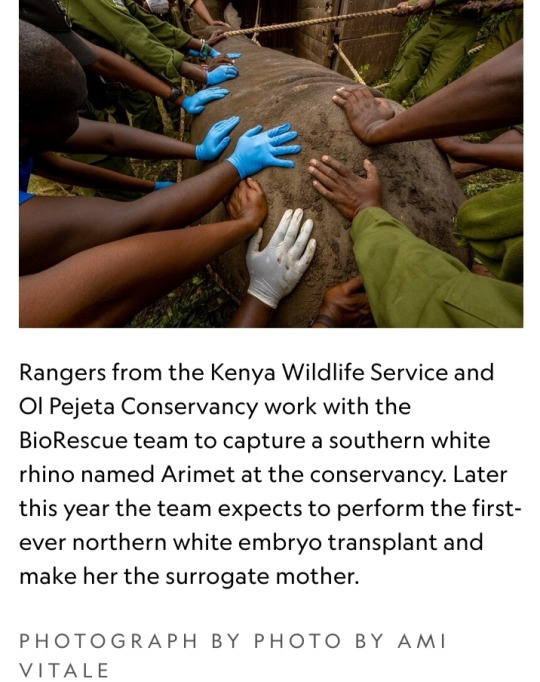
With so few northern white rhinos left, their genetic viability may seem uncertain.
But the BioRescue team points to southern white rhinos, whose numbers likely dropped to less than 100, and perhaps even as few as 20, due to hunting in the late 1800s.
Government protections and intense conservation strategies allowed them to bounce back, and now there are almost 17,000.
“They have sufficient diversity to cope with a wide range of conditions,” says Balfour.
Researchers don’t know exactly how many southern white rhinos existed a century ago, he says, but it’s clear that the animals came back from an incredibly low population count and that they now appear healthy.
Beyond their small collection of embryos, the BioRescue team hopes to expand the northern white rhino’s gene pool by drawing from an unconventional source — skin cells extracted from preserved tissue samples that are currently stored at zoos.
They aim to use stem cell techniques to reengineer those cells and develop them into sex cells, building off similar work in lab mice.
According to their plan, those lab-engineered sex cells would then be combined with natural sperm and eggs to make embryos, and from there, the embryos would be implanted into southern white rhino surrogate mothers.
Such stem cell reprogramming work has previously led to healthy offspring in lab mice, Hildebrandt says, but rhinos aren’t as well-studied and understood as mice, making this work significantly challenging.
A global effort
The northern white rhino revitalization venture has cost millions of dollars, supported by a range of public and private donors, including the German Federal Ministry of Education and Research.
Other partners on the effort include the Leibniz Institute for Zoo and Wildlife Research, the Czech Republic’s Safari Park, Kenya Wildlife Service, Ol Pejeta Conservancy, and also Katsuhiko Hayashi, a professor of genome biology at Osaka University in Japan who conducted the mouse stem cell research.
Building upon Hayashi’s stem cell techniques could ultimately bring the northern white rhino gene pool up to 12 animals — including eggs from eight females and the semen of four bulls, according to Stejskal.
An alternative approach to making more babies, like crossbreeding northern and southern white rhinos, would mean the resulting calves wouldn’t be genetically pure northern white rhinos, Hildebrandt notes.
The two subspecies look quite similar, but the northern version has subtle physical differences, including hairier ears and feet that are better suited to its swampy habitat.
The two animals also have different genes that may provide disease resiliency or other benefits, Hildebrandt says.
There are unknown potential differences in behavior and ecological impact when populating the area with southern white rhinos or cross-bred animals.
"The northern white rhino is on the brink of extinction really only due to human greed,” Stejskal says.
“We are in a situation where saving them is at our fingertips, so I think we have a responsibility to try.”
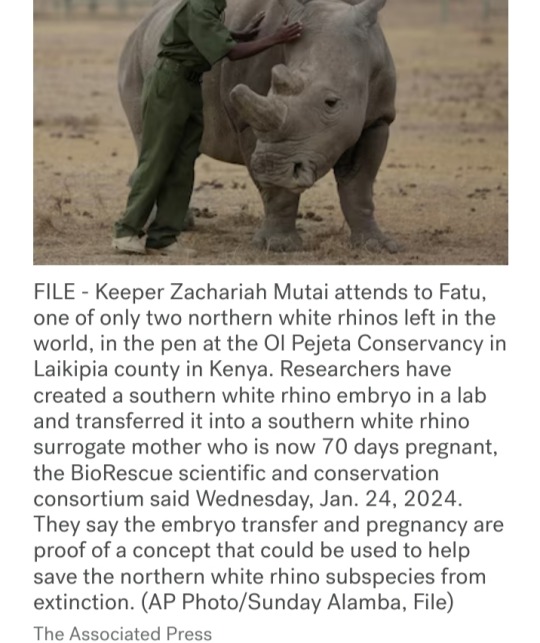
🩶🦏🩶
#northern white rhinoceros#rhino embryo transfer#in vitro fertilization#IVF#southern white rhinoceros#critically endangered animals#National Geographic#BioRescue#rhino horn#International Union for the Conservation of Nature#African rhino specialist group#Thomas Hildebrandt#German Federal Ministry of Education and Research#Leibniz Institute for Zoo and Wildlife Research#Kenya Wildlife Service#Ol Pejeta Conservancy#Katsuhiko Hayashi#genome biology#IVF rhino pregnancy
9 notes
·
View notes
Text

April 21, 2023 - Northern Crombec (Sylvietta brachyura) Found across much of central Africa, these African warblers live in open wooded habitats. They eat invertebrates, including their eggs and larvae, foraging in trees and shrubs, alone or in pairs or family groups, and often joining mixed-species flocks. They build deep pocket-shaped nests from plant stems, grasses, fibers, spiderwebs, fine rootlets, grass heads, cocoons, and small seeds, suspended by spiderweb from twigs of bushes or trees.
#northern crombec#crombec#african warbler#sylvietta brachyura#bird#birds#illustration#art#grassland#birblr art
50 notes
·
View notes
Text
Happy world penguin day!!

I am going to go over some interesting penguins, they could be interesting because of their names or adaptions.

These guys are the African Penguins. The African Penguin is the only one of 17 penguin species that lives in Africa. This penguin is also known as the Jackass penguin because they have a noisy squawks. These squawks sound like the braying of a donkey therefore getting the nickname the Jackass penguin. In the language Afrikaans they call the African penguins brilpikkewynn (pronounced bril as in brilliant-puh-kuh-vain), this translates to English as braying penguin.
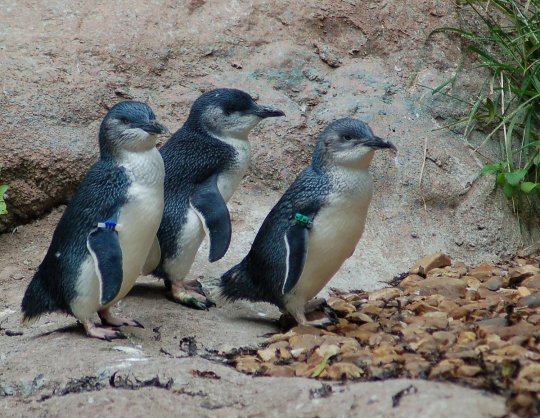
New Zealanders call these penguins Little Blue Penguins or just Blue Penguins. Australians call them Fairy Penguins.thw names come from the small size the fairy penguins have. Fairy penguins are actually the smallest species of penguin. The fairy penguins have indigo-blue or slate-blue feathers on their backs as you can see in the image above. The scientific genus name (Eudyptula) means good little diver. Fairy penguins do not migrate. They live year-round on their mainland or island locations in the southern hemisphere

Some species of penguins propose to each other with a pebble. Adélie penguins are actually one of those penguins. When the two penguins are dating, the male penguin will give the female a pebble. If the pebble is accepted by the female the two penguins will mate for life. When Adélie penguins mate for life and return to each other at the same nest every year. The nest will be a pile of pebbles.

The population status of eastern rockhopper penguins is unknown. The eastern rock hopper penguins are located on several islands in the Indian and Pacific oceans. The penguins specifically live in sub-artic locations, such as the Crozet and Kerguelen islands. Eastern rockhopper penguins spend most of their lives at sea and only return to land to molt and breed.

At least 85% of northern rockhoppers are located on the islands of the Atlantic ocean Gough and Tristan da Cunha. of the Tristan da Cunha archipelago and Gough Island in the Atlantic Ocean. The population of the Northern rockhoppers has decreased about 90% since the 1950s.
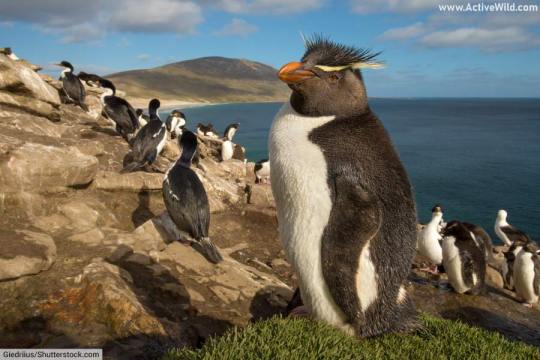
The Southern rockhopper penguins are classified as vulnerable and have decreasing population size. This species of rockhopper penguins live on the coastlines of Chile and Argentina, as well as the Campbell island in New Zealand. The Southern rockhoppers are found on several other islands in the Pacific, south Atlantic and Indian oceans. The Southern rockhoppers have a narrower stripe of yellow over their eyes than the Northern rockhoppers.

The Magellanic penguin is the most common type of banded penguin. They are a medium to large penguin that have a thick black line running across their white chest. Magellanic penguins have white border surrounding their face. During breeding season Magellanic penguins are found on the Falkland Islands as well as the coast of southern south America. In the winter they migrate as far north as northern Brazil.
There are also some gay penguins. People have served penguins engaging in homosexual behavior since as early as 1911. The first documented case of homosexual penguins was not released to the public until a century later due to the report being "considered too shocking for public release".
#magellanic penguin#jackass penguin#african penguin#fairy penguin#little blue penguin#adélie penguin#rockhopper penguin#northern rockhopper penguin#Southern rockhopper penguin#eastern rockhopper penguin#world penguin day#cute penguins#gay penguins#homosexual penguins
25 notes
·
View notes